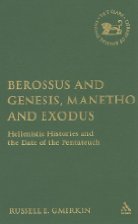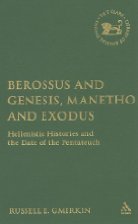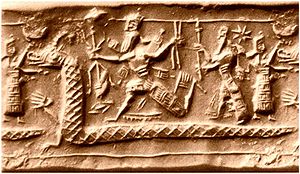https://www.youtube.com/watch?v=9znMWH3LC9E
Vridar posts on Russell Gmirkin’s books discussed in the podcast:
.
Musings on biblical studies, politics, religion, ethics, human nature, tidbits from science

https://www.youtube.com/watch?v=9znMWH3LC9E
Vridar posts on Russell Gmirkin’s books discussed in the podcast:
.

 What happens to the Documentary Hypothesis (DH) if, as outlined in recent posts, the Pentateuch was first written in the third century BCE? That’s the first question that comes to most of us when first hearing a thesis like this. This post outlines Russell Gmirkin’s chapter on the DH, and is thus a continuation of my summary of the early sections of his book, Berossus and Genesis, Manetho and Exodus: Hellenistic Histories and the Date of the Pentateuch.
What happens to the Documentary Hypothesis (DH) if, as outlined in recent posts, the Pentateuch was first written in the third century BCE? That’s the first question that comes to most of us when first hearing a thesis like this. This post outlines Russell Gmirkin’s chapter on the DH, and is thus a continuation of my summary of the early sections of his book, Berossus and Genesis, Manetho and Exodus: Hellenistic Histories and the Date of the Pentateuch.
(Other posts where I have discussed the DH, including other criticisms of it, are archived in the Documentary Hypothesis archive.
See Who Wrote the Bible? The Rise of the Documentary Hypothesis for the history of the DH’s origins.
For Julius Wellhausen’s Prolegomena to the History of Ancient Israel, the sacred-texts site contains one of the easiest-to-read online versions.
Another modern book worth reading in defence of the DH is Friedman’s The Bible With Sources Revealed.)
The different sources identified in the DH are not in dispute in Gmirkin’s thesis:
This book does not take issue with the Higher Criticism’s identification of different sources in the Pentateuch, each with its own consistent vocabulary, interests and theological outlook. (p. 22)
Gmirkin describes the DH as presented by Wellhausen. Its primary fault, he argues, is that it dates the hypothetical sources by means of what is in reality an unsupported construct of Israel’s history.
The entangling of dating issues with subjective historical constructs was a major flaw in Wellhausen’s approach. The Documentary Hypothesis as developed by Wellhausen illustrates the grave danger of circular reasoning inherent in dating texts by means of a historical construct to facilitate the dating of these same texts. (p. 5)
Gmirkin’s method of dating is, as explained in previous posts in this series, a separate and independent process.
In chapter 2 Gmirkin discusses the DH in some detail. He examines its function and development as a literary and as a historical theory, then considers the historical assumptions underpinning the thesis and finally looks at the external evidence impinging upon the validity of the DH.
The Documentary Hypothesis was both a literary theory (regarding identification and dating of Pentateuchal sources) and a historical theory (regarding the evolution of Jewish religion). The authors of the DH based its history of the Jewish religion directly on the biblical account, accepting that the cultic practices successively described in Genesis, Exodus, Joshua, Judges, Samuel and Kings reflected sequential historical periods in Jewish history. (p. 24)

In Berossus and Genesis, Manetho and Exodus: Hellenistic Histories and the Date of the Pentateuch Russell Gmirkin presents a case for the Books of Moses, Genesis to Deuteronomy, being based largely upon the writings of Babylonian and Egyptian historians:
His first task is to demonstrate that we have no evidence of any knowledge of the Pentateuch until after the appearance of those works.
In the previous post we overviewed Russell Gmirkin’s argument that there we have no evidence in Greek writings of any knowledge of the Pentateuch before the appearance of the Septuagint. Gmirkin shows that the authentic writings of Hecataeus of Abdera do reveal knowledge of Moses as a lawgiver, but the same writings do not show any knowledge of written Mosaic laws. Besides, as we will see in this post, the portrayal of Moses as the lawgiver followed the stereotypical pattern of leaders who led expeditions to found new Greek colonies: the laws were always given after the new settlement (with its cities, temple and tribal organization) was established in the new land.
This post explains how Gmirkin arrives at the date of around 270 BCE for the earliest appearance of the first books of the Bible. He concludes that
the first evidence of Pentateuchal writings is the Septuagint translation itself, probably dating to the late 270s BCE. (p. 72) Continue reading “Why the Books of Moses should be dated 270 BCE (clue: “Rabbits”)”

 I have been posting on the works of several scholars who argue that the Old Testament scriptures were composed much later than traditionally thought (Thompson, Davies, Lemche, Wesselius, Wajdenbaum) but there remains much more to be written about their arguments, and more published scholars to draw into the same net (Nielsen and Gmirkin are two of these). This post introduces the work of Russell E. Gmirkin. I look forward eventually to discussing where his criticisms intertwine with those of Wajdenbaum and others, and then to return to Wajdenbaum’s thesis that the Old Testament books are heavily indebted to classical Greek literature and myths. But there is much to be covered in the meantime, including further exploration into the similarities between the Histories by Herodotus and the collection of books from Genesis to 2 Kings (referred to as The Primary History) in the Bible. Gmirkin does not support the thesis that the biblical author borrowed from Herodotus, however. It’s a fascinating time to be reading a rich range of new views about the origins of the Hebrew Bible.
I have been posting on the works of several scholars who argue that the Old Testament scriptures were composed much later than traditionally thought (Thompson, Davies, Lemche, Wesselius, Wajdenbaum) but there remains much more to be written about their arguments, and more published scholars to draw into the same net (Nielsen and Gmirkin are two of these). This post introduces the work of Russell E. Gmirkin. I look forward eventually to discussing where his criticisms intertwine with those of Wajdenbaum and others, and then to return to Wajdenbaum’s thesis that the Old Testament books are heavily indebted to classical Greek literature and myths. But there is much to be covered in the meantime, including further exploration into the similarities between the Histories by Herodotus and the collection of books from Genesis to 2 Kings (referred to as The Primary History) in the Bible. Gmirkin does not support the thesis that the biblical author borrowed from Herodotus, however. It’s a fascinating time to be reading a rich range of new views about the origins of the Hebrew Bible.

Russell E. Gmirkin’s book, Berossus and Genesis, Manetho and Exodus: Hellenistic Histories and the Date of the Pentateuch, has attracted wildly different reviews. One can read some of these here, here and here. But just as interesting is to read how Gmirkin himself evaluates some of the views of (at least one of) the authors of one of the particularly “bad” reviews. But for anyone interested in exploring new scholarly understandings of the Old Testament Gmirkin’s ideas will certainly be thought-provoking. (I was made aware of Gmirkin’s book through a passing comment left on this blog by Niels Peter Lemche.)
I’ve also found a Youtube video outlining key parts of his thesis. But contrary to what this video appears to imply, Gmirkin himself does not (as far as I can tell) argue for the “primacy” of the Septuagint. He writes on page 249:
From the foregoing discussion, it appears that the activities of the Septuagint scholars of 273-272 BCE included composing the Pentateuch in Hebrew as well as translating it into Greek.
He argues for the two — the Greek and Hebrew versions — appearing around the same time.
http://www.youtube.com/watch?feature=player_embedded&v=awg52anmTb8
Here is how Russell Gmirkin himself introduces his thesis (my own emphasis and formatting as for all quotations):
This book proposes a new theory regarding the date and circumstances of the composition of the Pentateuch. The central thesis of this book is that the Hebrew Pentateuch was composed in its entirety about 273-272 BCE by Jewish scholars at Alexandria that later traditions credited with the Septuagint translation of the Pentateuch into Greek.
The primary evidence is
- literary dependence of Gen 1— 11 on Berossus’s Babyloniaca (278 BCE),
- literary dependence of the Exodus story on Manetho’s Aegyptiaca (ca. 285-280 BCE),
- and datable geo-political references in the Table of Nations.
A number of indications point to a provenance of Alexandria in Egypt for at least some portions of the Pentateuch. That the Pentateuch, utilizing literary sources found at the Great Library of Alexandria, was composed at almost the same date as the Alexandrian Septuagint translation provides compelling evidence for some level of communication and collaboration between the authors of the Pentateuch and the Septuagint scholars at Alexandria’s Museum.
The late date of the Pentateuch, as demonstrated by literary dependence on Berossus and Manetho, has two important consequences:
- the definitive overthrow of the chronological framework of the Documentary Hypothesis,
- and a third-century BCE or later date for other portions of the Hebrew Bible that show literary dependence on the Pentateuch. (p. 1)


The influences of Mesopotamian creation stories in Genesis are clear. But how those stories came to be re-written for the Bible is less clear. Russell E. Gmirkin sets out two possibilities in Berossus and Genesis, Manetho and Exodus: Hellenistic Histories and the Date of the Pentateuch:
The traditional Documentary Hypothesis view:
Around 1400 BCE the well-known Babylonian Epic of Creation, Enûm Elish, the Epic of Gilgamesh and other stories found their way through Syria and into the Levant where the Canaanites preserved them as oral traditions for centuries until the Israelites learned of them. Then around the tenth or ninth centuries these Israelites incorporated some of those myths into an early version of Genesis (known as J in the Documentary Hypothesis).
About four centuries later, around the fifth century, the authors of that layer of the Bible known as P took quite independently orally preserved overlapping Mesopotamian legends and used them to add additional details from those myths that had been preserved by the Jews orally throughout to the J stories.
Now one remarkable aspect of this scenario (accounting for the Mesopotamian legends underlying Genesis 1-11) that has been pointed out by Russell Gmirkin is that though they had been preserved orally for centuries by the Canaanites, in Genesis they are completely free from any evidence of Canaanite accretions. This should be a worry, says Gmirkin, because Canaanite influences are found throughout the rest of the Bible.
Gmirkin suggests that this traditional model of how the Babylonian legends came to be adapted in the Genesis narrative is strained, so he proposes an alternative.
The author/s of Genesis 1-11 borrowed directly from the early third century (278 BCE) Babyloniaca of the Babylonian priest Berossus. The sources for this work show that Berossus himself drew upon the Babylonian epics of Creation and Gilgamesh, and Gmirkin argues that some of his additions and interpretations found their way into Genesis. Moreover, the Epic of Creation that resonates in Genesis, the Enûm Elish, was quite unlike other Babylonian creation myths:
- the standard Babylonian myth of creation (e.g. Atrahasis Epic, Enki and Ninmeh) began with earth, not with waters;
- Enûm Elish was specifically associated with the cult of Marduk, localized in Babylon — its purpose was to explain why the Babylonian patron god, Marduk, had been promoted over the other gods.
Note also:
- during the late Babylonian period and Seleucid times, the Enûm Elish likely increased in significance, but was still only recited in Babylon’s New Year Festival;
- Berossus was himself a priest of Bel-Marduk in Babylon at this period. For Berossus, the Enûm Elish would have been the definitive creation epic.
The Enûm Elish was very likely unknown beyond the region of Babylonia until Berossus himself drew attention to its narrative for his wider Greek audience. Gmirkin believes the simplest explanation for the Enûm Elish’s traces in Genesis is that they were relayed through Berossus’s Babyloniaca.
Here is a table comparing the details of the Genesis Creation with those found in the Babylonian Creation Epic and in Berossus’s third-century work: Continue reading “The Genesis Creation Story and its Third Century Hellenistic Source?”